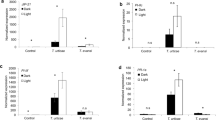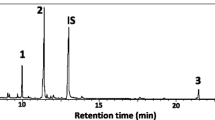Abstract
It has been suggested that previous infection by a vascular fungus causes induced resistance against two-spotted spider mites. To test the generality of this phenomenon, a series of experiments was carried out using two lines of tomato, differing only in resistance againstFusarium. In addition, tests were done in order to see whether the defense response against the fungus also affects the phytophagous mite directly. Inoculation of tomato plants with a vascular fungus (Fusarium oxysporum f.sp.lycopersici race 1) prior to infestation with spider mites caused a decrease in the rate of oviposition of two-spotted spider mites (Tetranychus urticae) on aFusarium-susceptible line, but only when plants were moderately to severely wilted. Spider mite oviposition did not change significantly of a previously inoculatedFusarium-resistant line.
AsFusarium causes vascular occlusion and wilting of the plants, drought stress was experimentally induced to determine its influence on the reduction of oviposition. Drought caused a significant reduction in spider mite oviposition. We conclude that the effect of previousFusarium-inoculation on spider mite oviposition is primarily due to the fungus affecting the quality of the host plant (including the effect it may have on the composition of defensive compounds), rather than due to the stimulation of the defense system of the plant. SinceFusarium seals off the xylem vessels, thereby causing wilting of susceptible plants, the reduction in mite oviposition may well be due to drought stress in the leaves, rather than due to the production of phytoalexins.
Similar content being viewed by others
References
Ajlan, A.M. and Potter, D.A., 1991. Does immunization of cucumber against anthracnose byColletotrichum lagenarium affect host suitability for arthropods? Entomol. Exp. Appl., 58: 83–91.
Beckman, C.H., 1987. The Nature of Wilt Diseases of Plants. A.P.S. Press, The American Phytopathological Society St. Paul, MN.
Biles, C.L. and Martyn, R.D., 1989., Local and systemic resistance induced in water melons by Forma Specialis ofFusarium oxysporum. Phytopathology, 79: 856–860.
English-Loeb, G.M., 1989. Nonlinear responses of spider mites to drought-stressed host plants. Ecol. Entomol., 4: 45–55.
English-Loeb, G.M., 1990. Plant drought stress and outbreaks of spider mites: a field test. Ecology, 71: 1401–1411.
Faeth, S.H., 1987. Community structure and folivorous insect, outbreaks: The roles of vertical and horizontal interactions. In: P. Barbosa and J.C. Schultz (Editors), Insect Outbreaks. Academic Press, New York, NY, pp. 135–171.
Hollingworth, C.S. and Berry, R.E., 1982. Two-spotted spider mite (Acari: Tetranychidae) in peppermint: population dynamics and influence of cultural practices. Environ. Entomol., 11: 1280–1284.
Karban, R., 1985. Resistance against spider mites in cotton induced by mechanical abrasion. Entomol. Exp. Appl., 37: 137–141.
Karban, R., and Myers, J.H., 1989. Induced responses to herbivory. Annu. Rev. Ecol. Syst., 20: 331–348.
Karban, R., Adamchak, R., and Schnathorst, W.C., 1987. Induced resistance and interspecific competition between spider mites and a vascular wilt fungus. Science, 235: 678–680.
Kogan, M. and Paxton, J., 1983. Natural inducers of plant resistance to insects. In: P. Hedin (Editor), Plant Resistance to Insects. Am. Chem. Soc. Symp. Series, Washington, DC, pp. 153–171.
Kuc, J., 1982. Induced immunity to plant disease. Bioscience, 32: 854–869.
Kuc, J., 1983. Induced systemic resistance in plants to diseases caused by fungi and bacteria. In: J.A. Bailey and B.J. Deverall (Editors), The Dynamics of Host Defense. Academic Press, New York, NY, pp. 255–273.
Kuc, J., 1987. Plant immunization and its applicability for disease control. J. Wiley, New York, NY, pp. 255–273.
Kuc, J., Schockley, G. and Kearney, K.K., 1975. Protection of cucumber againstColletotrichum lagenarium byColletotrichum lagenarium. Physiol. Plant Pathol., 7: 195–199.
Lewis, A.C., 1979. Feeding preference for diseased and wilted sunflower in the grasshopper,Melanoplus differentialis. Ecol. Entomol., 7: 391–395.
Mattson, W.J. and Haack, R.A., 1987a. The role of drought in outbreaks of plant-eating insects. BioScience, 37(2): 110–118.
Mattson, W.J. and Haack, R.A., 1987b. The role of drought stress in provoking outbreaks of phytophagues insects. In: P. Barbosa and J.C. Schultz (Editors), Insect Outbreaka, Academic Press, San Diego, CA, pp. 365–407.
McQuate, G.T. and Connor, E.F., 1990a. Insect responses to plant water defecits. I. Effects of water deficits in soybean plants on the feeding preference of Mexican bean beetle larvae. Ecol. Entomol., 15: 419–431.
McQuate, G.T. and Connor, E.F., 1990b. Insect responses to plant water deficits. II. Effect of water deficits in soybean plants on the growth and survival of Mexican bean beetle larvae. Ecol. Entomol., 15: 433–445.
Mellors, W.K. and Propts, S.E., 1983. Effects of fertilizer level, fertility balance, and soil moisture on the interaction of two-spotted spider mites (Acari: Tetranychidae) with radish plants. Environ. Entomol., 12: 1239–1244.
Oloumi-Sadeghi, H., Helm, C.H., Kogan, M. and Schoenweiss, D.F., 1988. Effect of water stress on abundance of two-spotted spider mite on soybeans under greenhouse conditions. Entomol. Exp. Appl., 48: 85–90.
Rhoades, D.F., 1983. Herbivore population dynamics and plant chemistry. In: R.F. Denno and M.S. McClure (Editors), Variable Plants and Herbivores in Natural and Managed, Systems. Academic Press, New York, NY, pp. 155–220.
Sumner, L.C., Need, J.T., McNew, R.W., Doeschner, K.W., Eikenbary, R.D. and Johnson, R.C., 1983. Response ofSchizaphis graminum (Homoptera: Aphidae) to drought stressed wheat using polyethylen glycol as a matricum. Environ. Entomol., 12: 919–922.
White, T.C.R., 1969. An index to measure wheather-induced stress of trees associated with outbreaks of psyllids in Australia. Ecology, 50: 905–909.
White, T.C.R., 1974. A hypothesis to explain outbreaks of looper caterpillars, with special reference to populations ofSelidosema suavis, in a plantation ofPinus radiata in New Zealand. Oecologia (Berlin), 16: 279–301.
White, T.C.R., 1976. Weather, food and plagues of locusts. Oecologia (Berlin), 22: 119–134.
White, T.C.R., 1984. The abundance of invertebrate herbivores in relation to availability of nitrogen in stressed food plants. Oecologia (Berlin), 63: 90–105.
Author information
Authors and Affiliations
Rights and permissions
About this article
Cite this article
Jongebloed, P.H.J., Elgersma, D.M. & Sabelis, M.W. Does a vascular fungus of tomato induce a defence response or a change in host plant quality that also affects the oviposition of spider mites?. Exp Appl Acarol 16, 227–236 (1992). https://doi.org/10.1007/BF01193805
Accepted:
Issue Date:
DOI: https://doi.org/10.1007/BF01193805




